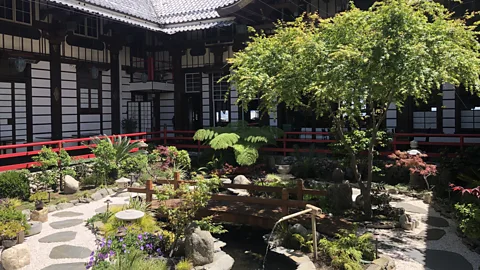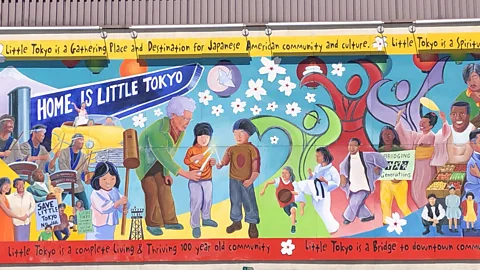Yamashiro: Los Angeles' secret mountain palace
 Mike MacEacheran
Mike MacEacheranConstructed more than 100 years ago, the Yamashiro Historic District is as fantastic as any story that Hollywood could put on the silver screen.
Stargazing takes on a different meaning in Los Angeles, especially in Hollywood. Always, the larger-than-life neighbourhood has an eye for the theatrical, and if you arrive at the intersection of Hollywood and Highland, you'll be greeted by Angelenos dressed as Mickey Mouse, Captain America, Darth Vader and more as they pose for photos on the Hollywood Walk of Fame.
Farther along is Disney's El Capitan Theatre where Jimmy Kimmel Live! is filmed every weeknight. Across the boulevard is the Dolby Theatre, the venue of the annual Academy Awards ceremony. Heading north, you'll see the iconic bandshell of the Hollywood Bowl amphitheatre, which draws all the stars – over the decades everyone from The Beatles to Fleetwood Mac to Jay-Z to Adele has played here. Altogether, it is an orbit of purpose and star power.
But hidden, almost out of sight, above this is somewhere equally spectacular, if far less well known. Indeed, there is almost nothing out of the ordinary on the approach along North Sycamore Avenue. Until, that is, the road curves steeply and a finial of a decorative wooden pagoda appears poking above a cordon of California palms.
This is Yamashiro, a hilltop mansion complete with a 300-seat Asian-inspired restaurant, bar, screening rooms and tiered ornamental gardens, waterfalls and pools at its centre. For in-the-know visitors, the estate represents one of Los Angeles' most memorable dining experiences. Rather, it has become a semi-mythic touchstone for fans of Japanese culture in California and an improbable movie set for blockbusters.
If the location of Yamashiro is pure LA — spoiler alert: the view spans from the Hollywood Sign to the Sunset Strip, picking out Griffiths Park Observatory and the distant high rises of Downtown LA in between — the estate itself is anything but. It was conceived in 1911 both as a 10-bedroom residence for German American brothers Adolph Leopold and Eugene Elija Bernheimer, but also, as Carina Quintero , my guide and the complex's marketing manager, explained, as "a museum of their collection of priceless antiquities — as a love letter to Japan".
 Mike MacEacheran
Mike MacEacheranAll agree it is magnificent, with a name that certainly befits such a place. For Yamashiro in Japanese translates as "mountain palace".
Trying to make sense of it all, I met with Quintero on a warm spring afternoon and we headed straight to the gardens, where switchback walkways, cherry blossom trees, sculpted plants, stone-hewn pools, a ceremonial sentry gate and ornamental summer house sit incongruously, 250ft above the movie theatres of Hollywood Boulevard below. Once there were 300 steps climbing through the garden, past a manmade lake home to rare Australian black swans. Now, 113 years after it was built, Yamashiro maintains an air of gentility a world apart from the attractions most LA visitors crave. One standout is a 600-year-old pagoda, the oldest structure in California with roots that can be traced all the way back to 14th-Century Japan where it was built.
"There's nothing else like this in California," said Quintero, as we walked the palace's mazy terraces. "Sometimes I forget how much history around me – it's certainly crazy enough for Hollywood."
What makes Yamashiro so intriguing is in the details. Historically, the complex was built as a replica of a mountain palace in Yamashiro — a prefecture near Kyoto that's home to more than 1,600 Buddhist temples. For much of the first three years of construction, hundreds of craftsmen were brought from Japan and China to ensure the teak and cedar architecture and rafters lacquered in gold and tipped with bronze dragons were faithful to the original. A grand monkey house, built in an identical style to house the brothers' collection of exotic primates and now housing a separate, leased-out restaurant, maintains the intriguing grace and delicacy of the estate.
 Mike MacEacheran
Mike MacEacheranToday, almost all of the antiquities collection is gone. The ukiyo-e (woodblock) prints, silk paintings, Buddhist sculptures, rare jades, bronzes, cloisonné chandeliers, tapestries and art from historic Satsuma province were auctioned in the mid-1920s following one of the brothers deaths. But wandering the complex, you still catch flashes of this curious past.
More like this:
• How an abandoned prison became the newest US national park
As Quintero and I entered the mansion, Hollywood slipped away and all of Los Angeles with it. Sunlight flooded inside an entrance hallway, highlighting hand-painted murals, silk wallpapers, tea chests and ornate woodwork. Doors peeled away to reveal a series of time-stopped chambers surrounding an inner courtyard filled with manicured plants and pools containing silver, black and gold-speckled koi.
Even richer is the story of what happened to Yamashiro in the late 1920s, just before the last brother exited the scene. The idea was to jump on the Hollywood bandwagon at the beginning of the industry’s golden age, and the mansion next served as the headquarters of the ultra-exclusive 400 Club, comprised of the motion picture elite. "The story circulating from the Roaring Twenties is that underpaid actresses came to act as escorts for the leading men of the time," explained Quintero. Though no one, curiously, can remember much more than that.
Of the other significant dates in Yamashiro's timeline, few rival the years during World War Two for drama. Following the bombing of Pearl Harbor in 1941, America was in the grip of anti-Japanese hysteria and Yamashiro soon became heavily targeted. While rumours it was used as a signal tower by the Japanese remain unfounded today, much of the palace's more decorative elements were vandalised and the property was quickly repurposed as a boys' school for the US military. Plywood boards and black paint, according to Quintero, were used in ham-fisted attempts to cover much of the building's history.
 Mike MacEacheran
Mike MacEacheranAcross Los Angeles, anti-Japanese sentiment accelerated, particularly in Little Tokyo in eastern Downtown LA. History now shows a vast swathe of Japanese and their American-born descendants — up to 125,000 around the United States, in fact — were soon incarcerated in concentration camps until they could prove their loyalty to the Stars and Stripes. It is, according to the enclave's Japanese American National Museum, home to the largest repository of Japanese American cultural items on the planet, the country's wartime shame.
"My father was incarcerated in a camp when he was two," Kristen Hayashi, the museum's curator and director of collections told me on the morning before my visit to Yamashiro. "So many people in this area were affected, so this museum is really one of consciousness because of what happened across Los Angeles and the whole country 80 years ago."
You can't see Little Tokyo, its Buddhist temples, Godzilla-scale wall murals or neon lights burning bright through the day from the terrace at Yamashiro. But the sense is there is a kindred spirit shared between the two.
Little Tokyo is now listed as one of the US' 11 most endangered places, while Yamashiro is protected on the National Register of Historic Places — and the estate continues to fire Hollywood's imagination. Quentin Tarantino shot key scenes of Kill Bill here. Memoirs of a Geisha substituted the hanamachi (red light) district of Gion in Kyoto for it. Nicholas Cage and Angelina Jolie played out scenes in Gone in 60 Seconds. So, too, did Bruce Willis and Kim Basinger in 1980s romcom Blind Date. Perry Mason solved crimes here. Richard Pryor once lived in an apartment on the grounds. Then there are stories involving Marlon Brando, Amy Adams, Charles Bronson, Jake Gyllenhaal, the cast of HBO's True Detective and dozens of others. It is history as tightly spooled as a celluloid reel.
This journey to Hollywood stardom has not been easy. Yet Los Angeles' ancient mountain palace has repeatedly changed the script. The compound is now livelier than ever – hosting up to 1,000 diners on weekend nights, thanks to current owners and LA entertainment moguls Freddy Braidi and Boulevard Hospitality Group – and the idea behind it remains as true as ever it was: to seduce those who play a fleeting role in its wider history, and, hopefully, to receive some kind of devotion in return.
There are many places in Hollywood prone to hyperbole, but Yamashiro, with its movie-worthy twists and reboots, isn't one of them.
--
If you liked this story, sign up for The Essential List newsletter – a handpicked selection of features, videos and can't-miss news, delivered to your inbox twice a week.
